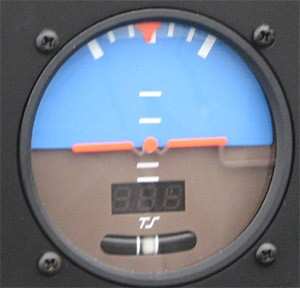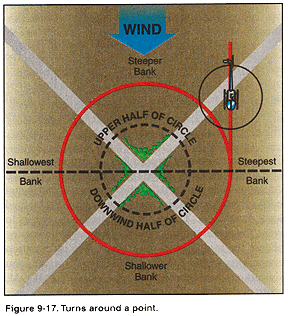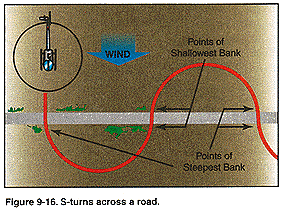Steep Turns, And Dallas "Breezes"
by ANN Managing Editor Rob Finfrock
"OK... make a shallow left turn... bring us gradually into the
wind, and let's see if we can't get this baby to hover."

No, I hadn't changed my intent to go through sport-pilot
training, to focus on rotorcraft instead. Rather, my
instructor and I were taking advantage of the Evektor SportStar's
benign slow-flight characteristics, and stiff late-January
breezes in the skies over Dallas, to conduct an experiment:
can an airplane hover, motionless, above a designated spot on the
ground?
"Keep it at 50... there we go... look at that!" I looked down at
the ground, forward of the SportStar's left wing. Yes, we were
still moving forward, relative to the ground -- but just
barely. Most importantly, the airspeed indicator read a solid 50
KIAS, give or take a knot or two -- well above stall speed in this
configuration.
With flaps at the maximum setting of 50 degrees, the plane
wasn't exactly "happy" -- I could feel it protesting through
the stick -- but I also got the impression it could fly like this
all day if needed.
"I've had it flying backwards before," my instructor for the
day, Kevin Hoffman, told me. (My primary instructor, Jay,
had handed off the lesson due to illness.) "OK,
recover and let's do some steep turns."
This second lesson came six days after my first at
Aviator Air in Grand Prairie, TX. The weather was much the same as
it had been on that first day: high overcast (above 6,000 feet...
high by Dallas-in-wintertime-standards), cold, with a pronounced
breeze. Actually, it would be fair to call it "wind" -- 12
knots gusting to 15, straight down the runway at ground level. As
our attempt at helo-impersonation had just shown, the winds were a
bit stronger at 2,000 feet above the ground.
 Which would make
this lesson's objectives all the more interesting. It was
time for ground reference maneuvers.
Which would make
this lesson's objectives all the more interesting. It was
time for ground reference maneuvers.
First, however, we did steep turns... which one does almost
entirely by sight and feel in the SportStar, even more so than in a
Cessna 172. Part of the reason is the instrumentation in the
smaller plane: the Sport features a TruTrak rate-based attitude direction
indicator (ADI, shown at right), instead of a
conventional attitude indicator.
The TruTrak also sports an instantaneous vertical speed
indicator, and an inclinometer (the ball in "step on the
ball.") That's handy from an all-in-one simplicity
standpoint, but it makes determining bank angle from the instrument
alone somewhat difficult.
Up to a 30 degree bank, the ADI is fairly accurate...
but the instrument hits a stop past that, so it doesn't register
steeper turns (another quirk of such an instrument: it registers
turns on the ground as you taxi.) That means the pilot's eyes are
forced to look outside the cockpit... which is where they should be
in the first place, really. (One remnant from my earlier student
training, is I still tend to look "inside" too much.)
"Perform a left 360 at 45 degrees," Kevin instructed. "Notice
how the picture outside looks."
The view through the SportStar's canopy made it surprisingly
easy for me to find the correct bank angle -- hey, whaddya know, it
LOOKS like we're banking at 45 degrees -- and the view over the
plane's short nose allows the pilot to plant it right on the
horizon, to maintain altitude through the maneuver. A quick twist
of the throttle added just a bit more power to keep the nose
up, and the increased g-load registering through my backside
told me we were in a true steep turn.
A blip of up-elevator trim kept the plane in the proper
orientation; I noted the rudder pedals were almost neutral,
with the left pedal in just a tad.
"Excellent!" Kevin told me as I rolled out, admittedly about
five degrees past the point I should have. "Now, do one to the
right." Surprisingly, again (I think I'll be using that word a lot
throughout these reports) the right 360 went much like the left one
had... and this time, I brought us back to the proper heading.
 After a few more steep
turns, we moved on to turns around a point -- picking a spot on the
ground, and keeping an equal distance from it as we fly a circle
around it. The strong winds meant I would need to bank steeply when
turning off downwind, and shallower when turning upwind, in order
to maintain that circle. (Graphics courtesy DynamicFlight.com).
After a few more steep
turns, we moved on to turns around a point -- picking a spot on the
ground, and keeping an equal distance from it as we fly a circle
around it. The strong winds meant I would need to bank steeply when
turning off downwind, and shallower when turning upwind, in order
to maintain that circle. (Graphics courtesy DynamicFlight.com).
Or that oval, anyway. My first few attempts to turn around a
completely circular irrigation pond -- thanks, unnamed farmer, for
placing that handy reference point there -- showed the "rust" in my
piloting skills more than any other maneuvers so far. I banked
steeply when I should have turned shallow; altitude suddenly became
a hypothetical value.
What was I doing wrong? As it turns out, the answer was "too
much too soon" -- not the first time I've encountered that problem,
nor was it the last time I'd see that tendency in my flight
training (as you'll read in Part Three).
The best I can describe it, is I was trying to fly the SportStar
like a Skyhawk -- i.e, a heavier aircraft. I was pulling up too
steeply as I turned in to the wind; I was adding too much throttle,
and pushing too far forward as we rolled out. I was fighting
the controls throughout the maneuvers... and the SportStar
dutifully responded, in a manner similar to a dog's warning growl.
The one that says "hey, stop that."
"Let me try that again," I said in disgust after rolling out of
the turn... before Kevin had the chance to say the same thing.
The second turn attempt was better... still not great,
though. The third one was better still -- by now, I
was getting a feel for the lighter efforts required.
"Wanna move on?" Kevin asked after I rolled out from the third
turn.
"One more?" I asked. My earlier disgust in my performance was
giving way to familiarity... and a feeling I was on the right
track.
"Sure."
 I'm happy to say I absolutely
nailed the fourth attempt.
I'm happy to say I absolutely
nailed the fourth attempt.
Compared to my almost-farcical tries at turns-around-a-point,
S-turns were a non-event. We picked a highway, and I flew a series
of esses over it. Simple as that... I even corrected for the winds
properly. After the second series, Kevin turned to me and said,
"you've got it. Let's head back."
On the way back to GPM, Kevin talked a bit about his flight
instructor experiences. He is a CFII, and also rated to instruct in
the G1000-equipped Cessna 172. "Did you know if you perform a steep
bank, say over 50 degrees, the XM radio shuts off?" he asked me. I
did not know that.
Echoing what Jay had told me, Kevin says he enjoys
instructing in the SportStar. "It's a real stick-and-rudder
plane."
As we approached the airport from the south, we flew
over the center of Joe Pool Lake, with Kevin instructing me to keep
a set distance from the shoreline. That required a slight crab to
the right to counteract the wind.
Shortly after that came the need to turn to the right, to
sidestep a CH-47 helo flying south over the lake. (I have a feeling
that by the end of my training, I'll be able to remember a
particular lesson by recalling where I saw the Chinook on that
flight.)
A call to the Grand Prairie tower indicated the winds were
now blowing from 30 degrees right of centerline for 35 -- which
meant I'd be performing my first crosswind landing in a SportStar!
According to the AWOS, the winds had calmed slightly -- about 10
knots steady.

I'd like to say I brought us down on the centerline; I'd
like to say a lot of things. Truth is, I landed flat
(again) well to the right of the line. The plane skidded left
slightly on its landing gear (that can't be good for
it, I recall thinking at the time) and I think Kevin helped
out a little on the controls, too. Darn it!
But after all, that's why this is called
training...
Coming Next Week: Pattern Work... And Rob Learns How
To Land
 ANN's Daily Aero-Linx (04.16.24)
ANN's Daily Aero-Linx (04.16.24) Aero-News: Quote of the Day (04.16.24)
Aero-News: Quote of the Day (04.16.24) Airborne 04.10.24: SnF24!, A50 Heritage Reveal, HeliCycle!, Montaer MC-01
Airborne 04.10.24: SnF24!, A50 Heritage Reveal, HeliCycle!, Montaer MC-01 Airborne 04.12.24: SnF24!, G100UL Is Here, Holy Micro, Plane Tags
Airborne 04.12.24: SnF24!, G100UL Is Here, Holy Micro, Plane Tags Airborne-Flight Training 04.17.24: Feds Need Controllers, Spirit Delay, Redbird
Airborne-Flight Training 04.17.24: Feds Need Controllers, Spirit Delay, Redbird







